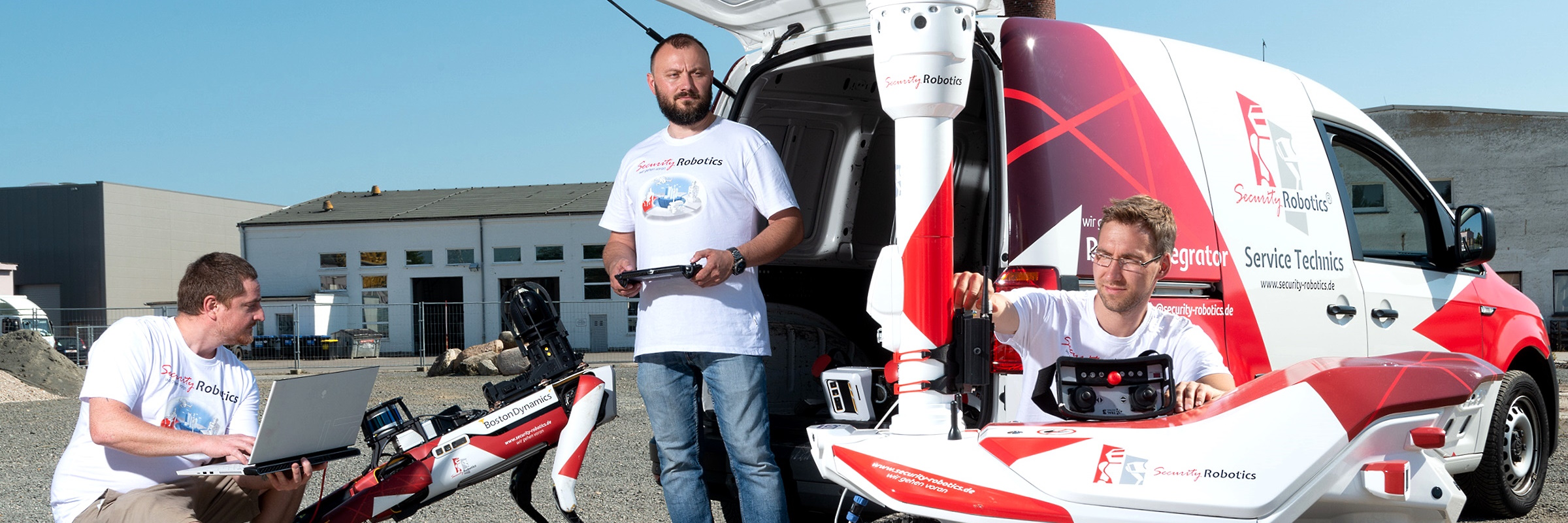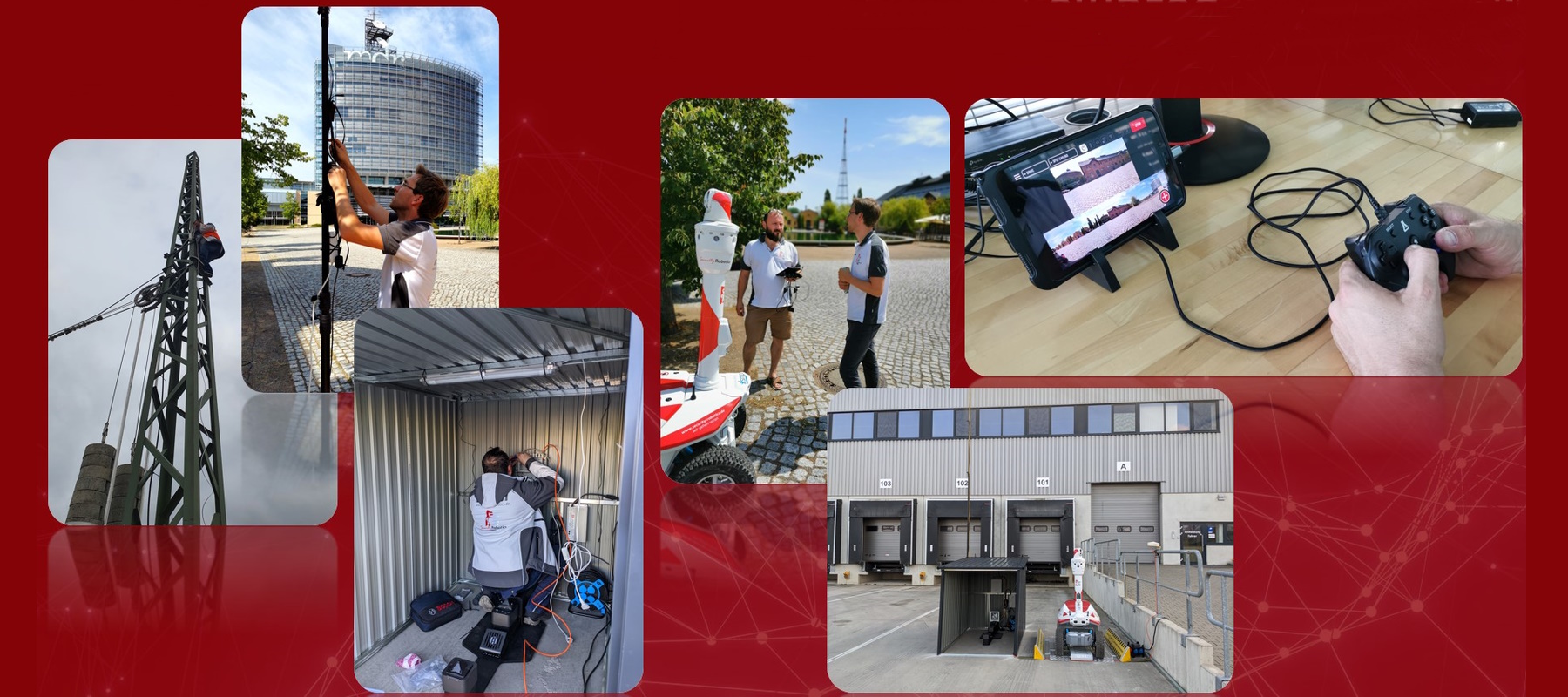
Support and Service
Open, modular, scalable, cascadable
Especially at the beginning, it takes a little more effort and commitment until everything meshes perfectly and the most diverse security components work hand in hand. During this process, we see ourselves as your reliable software developer and service provider, staying by your side and providing support wherever necessary. In this way, even complex integrations with a wide range of robotic systems and modules to be networked succeed without downtimes and without security gaps. Thanks to our experience with a wide range of scenarios, we know that each project has to be considered independently and therefore there cannot and must not be just one service level.

When it comes to support, we ourselves or service technicians accredited by us lend a hand. If possible, we try to solve all obstacles quickly and easily via remote control. If the problem is deeper-seated or involves regular maintenance, we analyse the software and hardware conditions and get to the bottom of the matter with a lot of experience.
Thanks to our system-open orientation, we can also deal with existing security technology and stabilise / optimise your security network. Our integrators, developers and technicians are well educated, trained, experienced in practice and have sufficient understanding of the customer’s needs.
On our in-house test site, we extensively test extended software features in beta status on a multitude of hardware variants, interfaces and application scenarios and incorporate these findings into our support services
Our support for you is therefore not a one-time thing after which we leave you out in the cold, but a service based on partnership that allows you to enjoy the sustainable added value of the integrated robotic systems and new features, as it should be!
You would like to dive deep into the details of our support options in a personal conversation? Are you a company with high technical expertise and service experience and are you looking for a partnership? Then don’t hesitate any longer and get in touch with us!
Contact us!
FAQ – Support and Service
Why are new functions extensively tested before they are used by customers?
Before new features are introduced and before robotics are deployed to customers, it is important to ensure that they work properly under all acceptable conditions. Through extensive testing, we can ensure that the new software features work reliably on different devices and in different situations.
An internal proving ground plays an essential role in the development of new software features for robotic and networking systems. Extensive beta tests on different hardware variants, interfaces and in different application scenarios ensure that the new functions meet the high quality standards. The diversity of the test site enables realistic testing, and the knowledge gained flows into further development and support processes. This ensures stable and optimised solutions for users.
What financial benefits do efficient support concepts offer?
Regular maintenance makes a decisive contribution to cost efficiency by minimising expensive repairs and unexpected downtime. Targeted prevention of potential problems and continuous optimisation of robotics and networked systems results in long-term cost savings. Customers benefit not only from an improved overall operating economy, but also from an optimised return on investment (ROI).
Preventive measures: Regular maintenance enables potential problems to be recognised and rectified at an early stage before they lead to major damage or failures. By using preventive measures, expensive repairs can be avoided, which contributes significantly to cost efficiency.
Minimisation of downtimes: Unplanned downtime can lead to significant financial losses. Regular maintenance optimises systems, which increases reliability and minimises the risk of unexpected downtime. This not only contributes to cost efficiency, but also enables smooth operation.
Long-term cost savings: The long-term perspective of regular maintenance leads to sustainable cost savings. By extending the service life of components and optimising systems, customers can benefit from lower operating costs in the long term.
Improved ROI: An optimised return on investment (ROI) is the result of effective and regular maintenance. Customers achieve greater value from their investment as systems are continuously kept up to date and their performance is maximised.
What should an effective service concept for autonomous robots include?
A comprehensive service for autonomous robots ensures that these systems operate continuously at the highest level. Regular inspections, software updates, hardware checks and effective troubleshooting are essential components of the service offering.
Regular inspections: The experts carry out regular inspections on the autonomously operating robots in order to recognise potential problems at an early stage and take preventative measures. This includes checking the hardware components, sensors, actuators and other relevant parts to ensure that everything is working properly.
Software updates: The dynamic nature of technology requires continuous adjustments and improvements to the software. The service therefore includes regular software updates to equip the autonomous systems with the latest functions, safety patches and performance improvements. This ensures that the robots are always at the cutting edge of technology.
Hardware checks: Detailed hardware checks are carried out to ensure optimum performance of the autonomous robots. This includes the evaluation of processors, memories, sensors, cameras and other hardware components. Any defects or signs of wear and tear are recognised and rectified at an early stage.
Troubleshooting: In the event of malfunctions or problems occurring, the service experts are on hand to carry out quick and efficient troubleshooting. This can be done both remotely and on site to ensure that the autonomous robots have as little downtime as possible.
A well thought-out concept therefore not only guarantees optimum performance, but also a long operational readiness and service life for the systems.
What happens in the event of a malfunction or failure of safety robots?
Carefully planned and effective support is crucial. A dedicated support team is available around the clock to ensure immediate action and minimise downtime.
Fast response times: An emphasis is placed on rapid response times to address critical situations immediately. Hotline staff respond to reports of critical failures within a short space of time and take the predefined measures immediately.
Remote support: The majority of problem solutions are provided via advanced remote support. Robotics experts can connect remotely to the autonomous systems to perform diagnostics, identify faults and initiate immediate action. This enables efficient problem solving without physical presence on site.
On-site intervention: In cases where remote support is not sufficient or physical intervention is required, technicians are ready to intervene on site. Fast and targeted on-site action minimises downtime and the autonomous systems are back up and running as quickly as possible.
Why is regular service and maintenance important for robotic systems?
Regular service and maintenance ensure the optimum performance and reliability of robotic systems. This includes checking hardware components, updating software and identifying potential problems before they lead to failures. Clever maintenance concepts score points with these benefits:
Optimising performance: regular inspections and maintenance work can identify potential bottlenecks, wear and tear or inefficient components at an early stage. This makes it possible to take targeted measures to optimise the overall performance of the robotic systems.
Extending the service life: Continuous maintenance helps to minimise the wear and tear of hardware components and thus extend the service life of the robotic systems. This leads to sustainable utilisation of the invested resources.
Preventive troubleshooting: The early identification of potential problems enables preventive troubleshooting before they lead to serious failures. This not only reduces downtime, but also minimises the cost of time-consuming repairs.
Software updates: With technology constantly evolving, regular software updates are crucial. These updates not only improve safety, but also bring new features and improved performance.
Ensuring operational safety: Regular maintenance ensures that robotic systems operate under optimal conditions. This ensures operational safety and reduces the risk of unforeseen failures during operation.
How does the integration of robots into existing safety infrastructures work?
The integration of robotic systems – including rented systems – into existing security infrastructures is carried out in close cooperation with the provider. This includes the customisation of interfaces, the configuration of communication protocols and coordination with existing monitoring systems. Through professional integration, companies can ensure that the robotic systems are seamlessly integrated into their existing security architecture.
Can robotic systems improve the response time to security incidents?
In a modern security concept, continuous monitoring, constant live access to all cameras and sensors and real-time alerts significantly improve all response times. The automated detection of security threats enables security forces to react more quickly to potential risks and take targeted measures. Part of these reactions, some of which are triggered automatically, involves the deployment of integrated security robots that can check and verify alarm messages very quickly. Drone systems, for example, are ideal for quickly providing the necessary overview, delivering high-resolution streaming data and thus reducing the potential impact of security incidents.